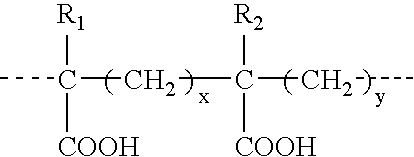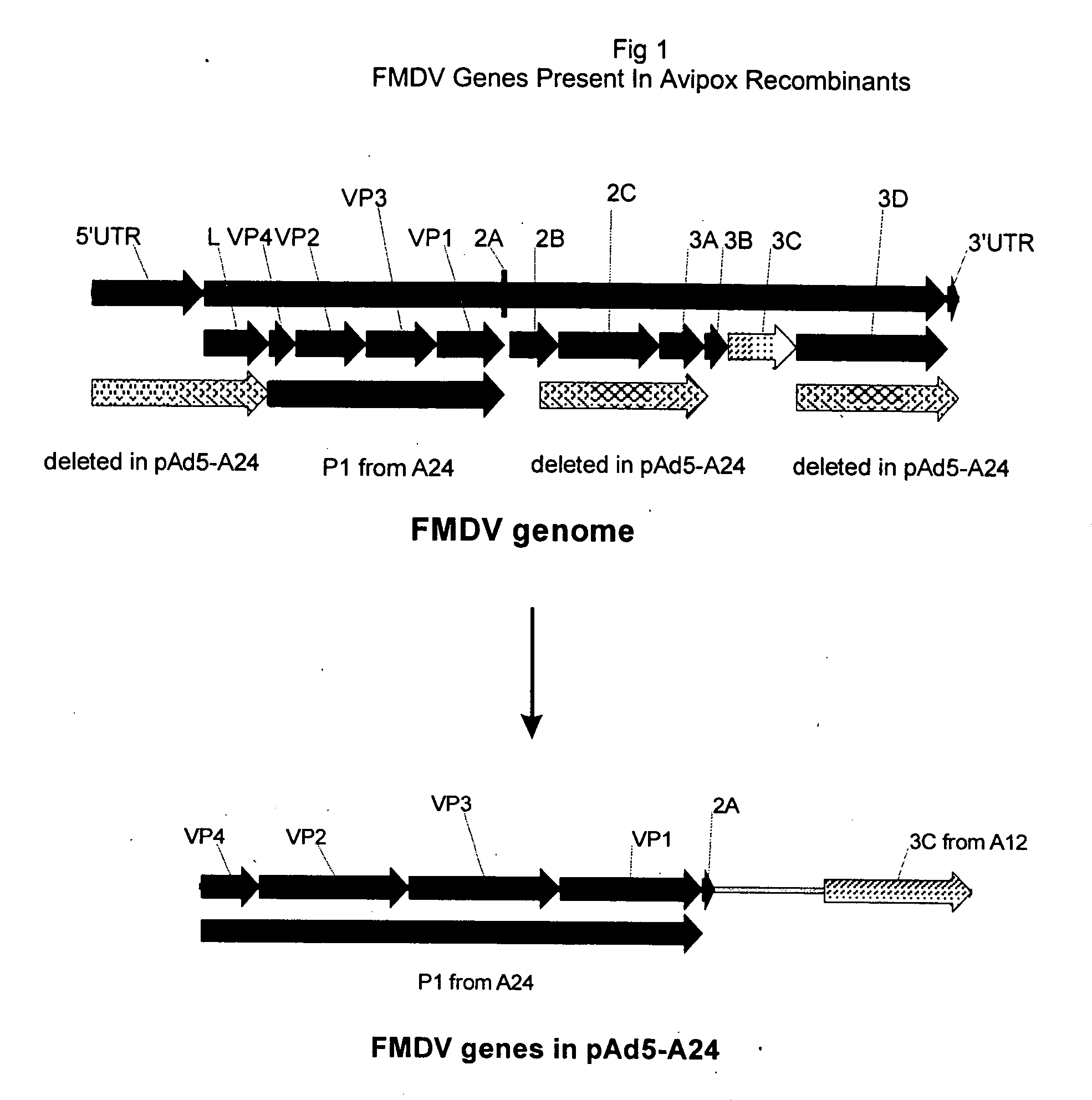Avipox recombinants expressing foot and mouth disease virus genes
a technology of vectors and avipox, which is applied in the field of vectors, can solve the problems of loss of productivity, periodic epidemics, and country with very severe economic consequences
- Summary
- Abstract
- Description
- Claims
- Application Information
AI Technical Summary
Benefits of technology
Problems solved by technology
Method used
Image
Examples
example 1
Construction of a pC5 H6p FMDV P1+3C Donor Plasmid for Introduction of FMDV Genes into the C5 Loci of ALVAC
[0113] Plasmid pAd5-A24 was used as the donor plasmid to generate the adenovirus Ad5A24 recombinant. It is a ˜39 kb plasmid containing the strain A24 P1 genes and the strain A12 3C protease. Several deletions of the FMDV genome were made for safety reasons and are indicated in FIG. 1.
[0114] Plasmid pAd5-A24 was digested with EcoRI and XbaI and the ˜3.4 kb fragment containing the FMDV genes was inserted in pUC8:2 (pUC8 with BglII and XbaI sites added to the multiple cloning site). The resulting 6 kb pUC FMDV plasmid (designated pHM-1119-1) was used as the source of the FMDV genes in all future constructs.
[0115] The H6 promoter (H6p) is an early / late promoter derived from the vaccinia H6 gene (Perkus, M. E. et al, (1989) J. Virol. 63: 3829-3836), which is designated as the H5 gene in the Copenhagen vaccinia strain. The H6p is a strong promoter that has been used extensively in...
example 2
Construction of a pF8 H6p FMDV P1+3C Donor Plasmid for Introduction of FMDV Genes into the F8 Locus of Fowlpox
[0119] Plasmid pSL-6427-2-1 (pF8 H6p) is a fowlpox insertion plasmid, which contains the vaccinia virus H6 promoter. The 3.4 kb NruI-BamHI fragment from pHM-1151-4 (pCR2.1 H6p FMDV; see Example 1) was inserted into pSL-6427-2-1, generating vector pHM-1180-11 (pF8 H6p FMDV P1+3C). The construction of pHM-1180-11 is illustrated in FIG. 5 and the sequence of the F8 H6p FMDV gene cassette is shown in FIG. 6.
[0120] Despite multiple attempts, no fowlpox recombinants could be generated from pF8 H6p FMDV P1+3C, pHM-1180-1.
example 3
Construction of a Promoter-Less pC6 FMDV P1+3C Insertion Plasmid
[0121] The failure to generate avipox recombinants expressing FMDV genes could be due to to the use of the strong vaccinia virus H6 promoter in the pC5 H6p FMDV P1+3C and pF8 H6p FMDV P1+3C plasmids described in Examples 1 and 2. In addition, the ALVAC donor plasmid results in the insertion of gene cassettes at the two C5 loci. For ALVAC, different viral promoters and the unique C6 insertion locus was used.
[0122] Plasmid pHM-1119-1 (pUC FMDV, see Example 1) was used as the template for PCR amplification of a 3′-fragment of FMDV, with primers 11280.SL and 11352.CXL. The ˜900 bp PCR fragment contains the 3′-end of FMDV from the XhoI site and introduces translational and transcriptional stops and a PstI cloning site. The primers are illustrated in FIG. 7. The PCR fragment was cloned into pCR2.1, generating plasmid pHM-1240-2, pCR2.1 3′-FMDV.
[0123] Plasmid pC6L is an ALVAC insertion plasmid for the unique ALVAC C6 site. ...
PUM
| Property | Measurement | Unit |
|---|---|---|
| diameter | aaaaa | aaaaa |
| molecular weight | aaaaa | aaaaa |
| molecular weight | aaaaa | aaaaa |
Abstract
Description
Claims
Application Information
 Login to View More
Login to View More - R&D
- Intellectual Property
- Life Sciences
- Materials
- Tech Scout
- Unparalleled Data Quality
- Higher Quality Content
- 60% Fewer Hallucinations
Browse by: Latest US Patents, China's latest patents, Technical Efficacy Thesaurus, Application Domain, Technology Topic, Popular Technical Reports.
© 2025 PatSnap. All rights reserved.Legal|Privacy policy|Modern Slavery Act Transparency Statement|Sitemap|About US| Contact US: help@patsnap.com



